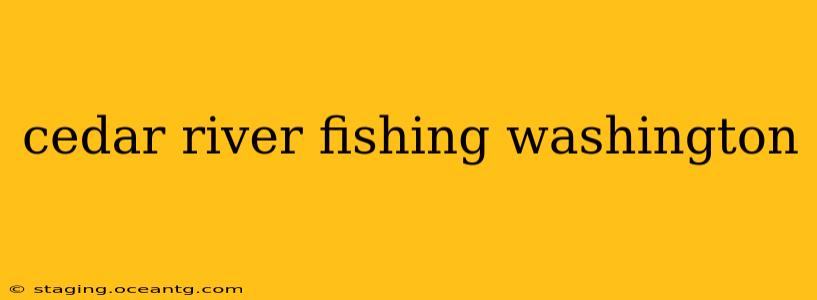The Cedar River, a tributary of Lake Washington, offers anglers a diverse and rewarding fishing experience. Known for its salmon runs, steelhead, and resident trout populations, this river provides opportunities for both experienced anglers and beginners. This guide will explore the best times to fish, popular fishing spots, the types of fish you can expect to catch, and essential tips for a successful fishing trip on the Cedar River.
What are the best times of year to fish the Cedar River?
The best time to fish the Cedar River depends on the species you're targeting. For salmon, the fall months (typically September through November) are prime time, coinciding with the fall Chinook and coho runs. Steelhead fishing is best in the winter and spring months, with peak seasons varying slightly depending on water conditions and river flow. Trout fishing is generally good throughout the spring, summer, and fall, offering consistent opportunities for catching rainbow, cutthroat, and brook trout.
What kind of fish can you catch in the Cedar River?
The Cedar River boasts a variety of fish species, making it a popular destination for anglers. The most sought-after species include:
- Chinook Salmon: These powerful fish make their way up the Cedar River in the fall, offering thrilling battles for anglers.
- Coho Salmon: Smaller than Chinook, Coho salmon also migrate up the river in the fall and provide excellent sport fishing.
- Steelhead: These anadromous trout are highly prized by anglers for their fighting ability and acrobatic jumps.
- Rainbow Trout: Resident rainbow trout can be found throughout the river, offering consistent fishing opportunities.
- Cutthroat Trout: These native trout are less abundant than rainbows but still provide a rewarding catch.
- Brook Trout: Less common than rainbows and cutthroat, but a prized catch for many anglers.
What are the best fishing spots on the Cedar River?
The Cedar River offers numerous access points and fishing spots catering to different fishing styles. Some popular locations include:
- Sections near Renton: This area provides easy access and often holds good numbers of resident trout.
- Areas upstream of Lake Washington: These areas are known for their salmon and steelhead runs during their respective seasons. Specific locations are best identified through local fishing reports and maps.
- The various tributaries: Smaller streams feeding into the Cedar River can also be productive, particularly for trout.
What are the fishing regulations for the Cedar River?
It is crucial to be aware of and adhere to Washington State fishing regulations. These regulations cover things like:
- Licenses and permits: You need a valid Washington State fishing license.
- Catch limits: There are limits on the number and size of fish you can keep.
- Gear restrictions: Certain types of fishing gear may be prohibited.
- Specific regulations for different species: Regulations often vary depending on the species of fish being targeted.
Always check the Washington Department of Fish and Wildlife (WDFW) website for the most up-to-date information on fishing regulations before your trip.
What kind of gear do I need for fishing the Cedar River?
The type of gear you'll need depends on the species you're targeting and the fishing method you prefer. Generally, you'll need:
- Rod and reel: A medium-light to medium action rod and reel combination is suitable for most species.
- Line: Use appropriate line weight based on your rod and the species you are targeting.
- Hooks and lures: Choose hooks and lures appropriate for the type of fish you are pursuing. Popular choices include spinners, spoons, and various flies.
- Waders (optional but recommended): Waders will keep you dry and comfortable while fishing in the river.
Are there guided fishing trips available on the Cedar River?
Yes, several local guides offer guided fishing trips on the Cedar River. These guides can provide valuable insight into the best fishing spots, techniques, and regulations, greatly enhancing your fishing experience.
What are some safety tips for fishing the Cedar River?
Fishing safely is paramount. Remember to:
- Check weather conditions before you go.
- Wear appropriate clothing and footwear.
- Be aware of your surroundings.
- Let someone know where you are going and when you expect to return.
- Always follow safety guidelines.
By following this comprehensive guide and staying informed about current fishing regulations and conditions, you'll be well-prepared for a successful and enjoyable fishing experience on Washington's Cedar River. Remember to practice Leave No Trace principles and respect the environment.
